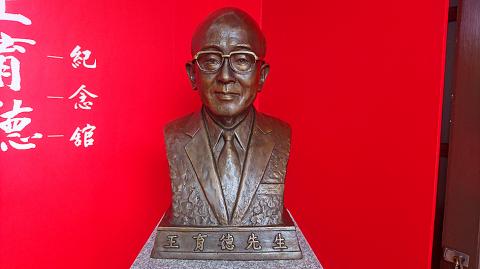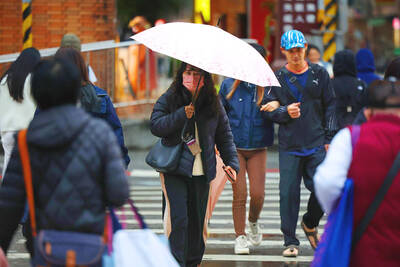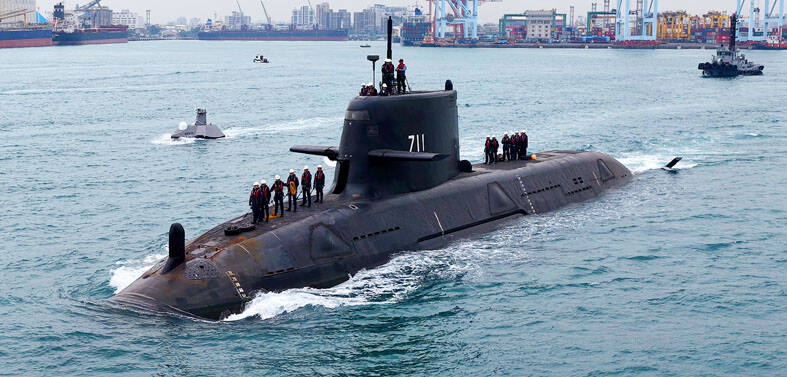A museum dedicated to independence activist Ong Iok-tek (王育德) yesterday opened at his former residence in Tainan, where he lived with his elder brother Ong Iok-lim (王育霖).
Born in 1924, Ong Iok-tek was a spiritual leader and forerunner of the Taiwanese independence movement in Japan. He was also an expert on the Hoklo language (commonly known as Taiwanese).
Ong Iok-lim, who was born in 1919, was the first Taiwanese prosecutor in the Japanese Empire.

Photo: Liu Wan-chun, Taipei Times
After World War II, he returned to Taiwan and served as a prosecutor in Hsinchu City, but resigned after investigating then-Hsinchu mayor Kuo Shao-tsung (郭紹宗) for corruption.
Ong Iok-lim was killed during the 228 Incident in 1947.
In 1949, Ong Iok-tek fled to Japan through Hong Kong with only one suitcase in hand.
In 1960, while in Japan, he founded the Taiwan Youth Society, a political group that published a magazine titled Taiwan Youth (台灣青年).
In 1969, he received a doctorate from the University of Tokyo for his studies on Hoklo, becoming the first person to do so.
In 1974, he began campaigning for the rights of Taiwanese who had served in the Japanese military during the Japanese colonial era, but died of a heart attack in 1985, at the age of 61, before he could see the result of his efforts.
In 1986, the Japanese government passed a resolution to pay ¥2 million (US$18,017 at the current exchange rate) to each of the families of the Taiwanese soldiers who were killed in combat or to survivors who had been severely injured.
In 2002, Avanguard Publishing House published the complete works of Ong Iok-tek in Chinese.
Originally written in Japanese, Taiwan: A History of Agonies (台灣 — 苦悶的歷史), which has also been translated into English, is one of Ong Iok-tek’s most important works and is made up of 15 volumes.
Ong Iok-tek’s 93-year-old wife, Wang Mei-hsueh (王雪梅), daughter Wang Ming-lee (王明理) and granddaughter Aya Kondo, as well as other family members, traveled from Japan to attend yesterday’s plaque hanging and opening ceremony at the museum.
Several Japanese reporters were also present.
Many of Ong Iok-tek’s personal belongings are exhibited at the museum, including the suitcase he carried when he fled Taiwan, his report cards from school, photographs, manuscripts and clothing.

SHIPS, TRAINS AND AUTOMOBILES: The ministry has announced changes to varied transportation industries taking effect soon, with a number of effects for passengers Beginning next month, the post office is canceling signature upon delivery and written inquiry services for international registered small packets in accordance with the new policy of the Universal Postal Union, the Ministry of Transportation and Communications said yesterday. The new policy does not apply to packets that are to be delivered to China, the ministry said. Senders of international registered small packets would receive a NT$10 rebate on postage if the packets are sent from Jan. 1 to March 31, it added. The ministry said that three other policies are also scheduled to take effect next month. International cruise ship operators

NUMBERS IMBALANCE: More than 4 million Taiwanese have visited China this year, while only about half a million Chinese have visited here Beijing has yet to respond to Taiwan’s requests for negotiation over matters related to the recovery of cross-strait tourism, the Tourism Administration said yesterday. Taiwan’s tourism authority issued the statement after Chinese-language daily the China Times reported yesterday that the government’s policy of banning group tours to China does not stop Taiwanese from visiting the country. As of October, more than 4.2 million had traveled to China this year, exceeding last year. Beijing estimated the number of Taiwanese tourists in China could reach 4.5 million this year. By contrast, only 500,000 Chinese tourists are expected in Taiwan, the report said. The report

Temperatures are forecast to drop steadily as a continental cold air mass moves across Taiwan, with some areas also likely to see heavy rainfall, the Central Weather Administration (CWA) said. From today through early tomorrow, a cold air mass would keep temperatures low across central and northern Taiwan, and the eastern half of Taiwan proper, with isolated brief showers forecast along Keelung’s north coast, Taipei and New Taipei City’s mountainous areas and eastern Taiwan, it said. Lows of 11°C to 15°C are forecast in central and northern Taiwan, Yilan County, and the outlying Kinmen and Lienchiang (Matsu) counties, and 14°C to 17°C

STEERING FAILURE: The first boat of its class is experiencing teething issues as it readies for acceptance by the navy, according to a recent story about rudder failure The Hai Kun (海鯤), the nation’s first locally built submarine, allegedly suffered a total failure of stern hydraulic systems during the second round of sea acceptance trials on June 26, and sailors were forced to manually operate the X-rudder to turn the submarine and return to port, news Web site Mirror Daily reported yesterday. The report said that tugboats following the Hai Kun assisted the submarine in avoiding collisions with other ships due to the X-rudder malfunctioning. At the time of the report, the submarine had completed its trials and was scheduled to begin diving and surfacing tests in shallow areas. The X-rudder,